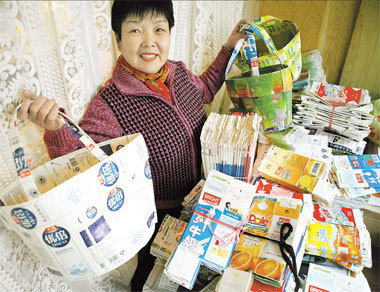 |
|
Jiang Meigui, 55, is obsessed with transforming all kinds of Tetra Pak milk boxes and soft drink bottles into fashionable handbags. [Photo: Shanghai Daily] |
Entering Jiang Meigui's home, you cannot miss the colorful tote bags piled in the corner. Jiang is not a fashionable collector of bags but a recycling activist. All the carry-all bags are made of hard-to-recycle milk and juice boxes.
Jiang, 55, is a volunteer official in her community and environmental protection is her passion. Since July 2005 she has been collecting empty Tetra Pak (a brand of package) milk boxes (950ml) and soft drink bottles since she heard that Tetra Pak had a recycling program to reuse the boxes.
Jiang and her friends washed and collected more than 3,000 boxes with the help of her friends, but they found that program had been discontinued, she said.
"It was a headache to deal with the boxes," she says. "You cannot just pile them there."
That summer Jiang put her boxes to good use. She started handicraft classes to teach children how to make use of the boxes. They made hats, boots, aprons and paper "mobile phones."
"They are very good materials," says Jiang. "The paper is thick, water-proof, easy to shape, and extremely good looking. Kids love that."
And since then, Jiang convinced about 50 retired ladies to collect Tetra Pak boxes for environmental protection. They called themselves the Residents Consciousness Committee, now the Green Housewife Association.
"Making a Tetra Pak box is very expensive, it's almost 60 percent of the cost of the drink," says Jiang. "It uses not only paper but also metallic foil. Throwing it away is such a waste."
The ladies not only collect empty boxes at home, but they scour the streets, even telling guys at the basketball court to save their boxes.
So far, they have more than 80,000 boxes. Jiang resold some to the Tetra Pak company for recycling use and made handicrafts with the others.
When China imposed a ban on free plastic bags at supermarkets and many retail shops, Jiang began designing shopping bags made of the milk boxes. She uses the same label on one bag, so everything matches.
"I've tried many styles and finally decided on one with an oval bottom and trapezoid sides," says Jiang.
Her bags won first prize in the Intel Environmental Creative Making Competition in June. Now shopping with a bag made of milk boxes has become a fashion and an environment statement in Jiang's community. The bags are given away at no charge. There are small bags for fragile eggs, and larger ones for other vegetables and groceries.
Jiang now teaches other communities how to make bags out of milk boxes.
"It is not difficult at all," says Jiang. "You should make one for yourself."
(Shanghai Daily November 25, 2008)